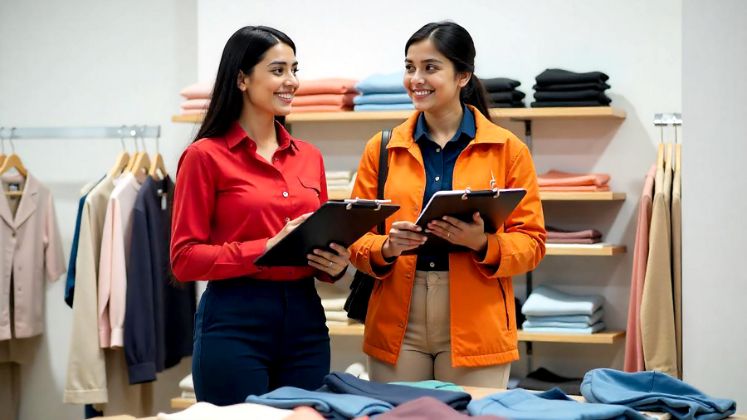India’s retail sector is racing towards a projected US $ 2.5 trillion by 2035, powered by a transformation in which digital and physical experiences are no longer separate but interconnected. The once-linear purchase journey has evolved into a discovery-driven loop influenced by online content, social influence and in-store experiences.
Embrace the rise of social commerce as consumers increasingly look to their social networks for research and advice before making a purchase, particularly on mobile apps. 43% of global consumers use social media to search for products and services. Indian consumers have now begun their shopping journey not on shelves but on screens. Platforms like Instagram and Google have replaced store aisles as the primary sources of discovery. Globally, 43% of consumers search for products on social media, but this number has risen to 68% in India’s Tier- 2 and Tier-3 cities.
Following the ban on TikTok in 2020, Instagram, with 400–500 million Indian users, has become the default short-form content platform. For 59% of shoppers, Reels serve as a key discovery tool. Influencers, in particular, shape consumer behaviour: 72% of Gen Z shoppers seek inspiration from them. Invest in creator partnerships, recognising these individuals’ influence in embedding trust and inspiring consumer purchasing decisions. Brands looking to reach younger consumers should invest heavily in this area. To stand out, brands must focus on visual appeal. Over 85% of Indian online shoppers prioritise visual content over text. The focus should be on creating authentic content led by visual storytelling to spark genuine curiosity and gain new brand fans through discovery and inspiration. Look to Pinterest as an opportunity. As 96% of searches are unbranded, this provides an opportunity for brand discovery. Use the right keywords and visually group items to spark interest.
`New tools like LykDat (which enables image-based searches) and Revieve (which uses AI to match uploaded photos to products) are reshaping the visual-to-purchase journey.
Turning Digital Buzz Into Footfall
Online discovery increasingly leads consumers to physical stores—but they arrive informed, inspired and ready to purchase. Stores must reflect digital trends in their visual merchandising, aligning what’s on display with what’s trending online. This strategy is crucial as India’s Rs. 10–25 lakh income households are expected to reach 140 million by 2025. To tap into this opportunity, brands are curating in-store assortments around hyperlocal festivals and community-specific events, especially in non-metros where such efforts resonate deeply.
Digital insights—top-searched products, wish lists and social sentiment—are also guiding decisions on product placement and stock rotation. With nearly 39 billion apparel items projected to be sold annually by 2027, agility is key.
Service Becomes Personal And Smart
Bridging online discovery and offline sales requires a human connection. Retail staff are no longer just shop assistants; they’re stylists, influencers and advisors. Armed with training and tech, they can replicate influencer-inspired looks and provide personalised styling.
Technology augments this. Myntra’s ‘Maya’ (a stylist bot powered by ChatGPT) and Tata CLiQ Luxury’s ‘Tara’ are reshaping service experiences. FableStreet’s FS FITS algorithm, based on body data from 100,000 Indian women, is helping solve fit-related concerns. Returns and after-sales service are evolving too. AJIO and Delhivery’s tech-enabled return process has improved resale quality from 25% to 98%. Blinkit now offers 10-minute returns. WhatsApp, with over 850 million users in India, has emerged as a key service channel—used by brands like CaratLane for ring consultations and The Souled Store for product previews and community engagement.
Leverage Emerging Technologies
For Indian consumers, omnichannel is the norm, not the exception. Shoppers expect continuity between online and offline touchpoints, with features like ‘buy online, try in-store’ becoming standard. Retailers must integrate customer data across channels to deliver truly personalised experiences. This is why digital-first brands are increasingly launching physical stores. Global giants are leading the way—Walmart’s mobile app offers a ‘Store Mode’, while Zara enables customers to reserve fitting rooms via its app.
New developments in AI and data tools can facilitate a more curated and connected experience for shoppers, allowing them to move easily between IRL stores, mobile apps and web and social platforms. Test and explore new AI-powered tools within app experiences such as chatbots, enhanced product recommendations and search functions that now can include natural language and visual and voice-powered search. After introducing visual search to its app experience, Amazon saw a 70% increase in visual searches, facilitating a better connection between users’ online and IRL browsing habits and the shopping app. Take advantage of new developments in mobile device hardware to enhance the shopping experience. For example, Google’s 2024 launch of Circle to Search, a feature now baked into many Android mobile devices, allows users to circle a specific element of any photograph and obtain specific search results for that area.
In India, accessibility is central. Flipkart’s app supports 11 regional languages, runs on low-end smartphones and offers flexible payment options.
Other Trends
1. 2025 Trends: Silver Generation Set To Rule Fashion
2. 2025 Trends: Ethnicwear Set To Shine
3. 2025 Trends: Bharat Retail To Go Compact, Lean
4. 2025 Trends: Q-Commerce To Fuel Fashion In Small Cities
5. 2025 Trends: Brands Must Speak Bharat
6. 2025 Trends: Buy Now, Pay Later To Ignite Shopping Boom
7. 2025 Trends: Athleisure To Go Full Throttle
85%Over 85% of Indian online shoppers prefer visuals over text. Authentic, visually-led storytelling sparks curiosity and builds new-age brand loyalty. Platforms like Pinterest— with 96% unbranded searches— offer major discovery potential. 140 MnBy 2025, India will have 140 million households earning Rs. 10–25 lakh. Smart brands are tapping into this by tailoring in-store collections to hyperlocal festivals and community events—especially in non-metros. 600 MnIndia’s live commerce market is set to hit US $ 4–5 billion by 2025, with fashion driving 60–70% of sales. With 350 M+ digital shoppers and 600 M short-form video users, the growth runway is massive. |
Live Commerce: The Ultimate Convergence
Nowhere is the blend of content, community and commerce more apparent than in live commerce. With a conversion rate of 25%—vastly higher than the average 2% on e-commerce websites—live commerce is redefining retail engagement.
India’s live commerce market is projected to reach US $ 4–5 billion by 2025, with fashion accounting for 60–70% of GMV. The potential is immense: 350+ million digital shoppers and 600 million short-form video users expected by 2025.
Leverage AI-powered shopping assistants in multiple languages to personalise product recommendations, answer customer queries and simplify decision-making. Incentivise quick purchases to increase conversion rates. With 46% of Indian consumers looking for on-sale products to reduce spending, leverage a time-based offer on products in livestreams to convert uncertain shoppers. The key lies in real-time interaction. Platforms like Flipkart have embedded ChatGPT-powered assistants like Flippi into live streams, making the purchase journey seamless. With 70–75% of Indian internet users preferring native languages, localised content and creators are critical, especially in Tier-2 and Tier-3 markets. Homegrown platforms like Roposo are helping brands connect with local audience, as seen in their collaboration with Lakmé Fashion Week. Virtual gifting on these platforms is also growing, with the market expected to hit US $ 1.7 billion by 2030.
Retail evolution is marked by scale, complexity and incredible potential. To win, brands must move beyond piecemeal strategies. Success depends on adopting a holistic, phygital approach that’s tech-enabled and data-driven.







